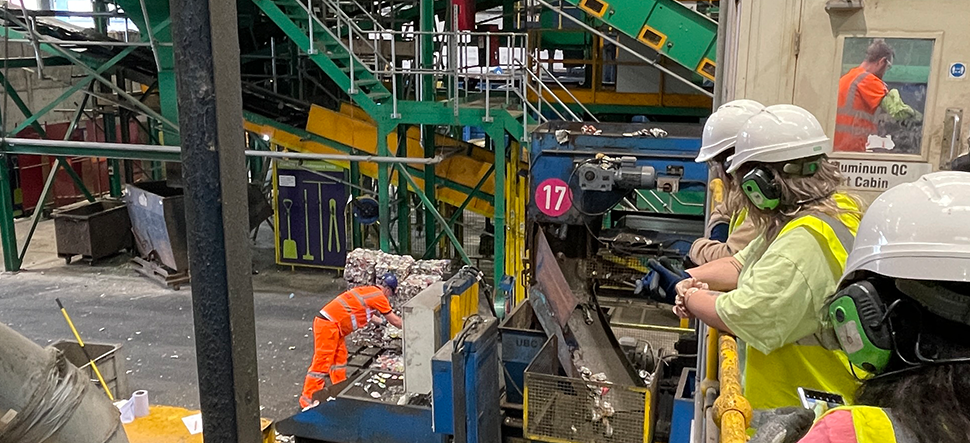
15, October 2023
Behind the Scenes at the Recycling Centre
Recycling Week’s about to begin. You might be a dedicated recycler, making sure you put all your waste in the right bin, but what happens to the items sent for recycling? We’ve been wondering the same. To find the answers, we took a behind-the-scenes tour of our local recycling centre.
How is Recycling Separated?
We visited Longley Lane Materials Recovery Facility in Manchester. This huge plant processes the household waste for almost all of Greater Manchester (every borough except Wigan). Our guide, Alison, told us that’s up to 300 tonnes a day!
The ‘Mixed Recycling’ that arrives at Longley Lane comprises glass, plastic bottles, steel tins and aluminium cans. That’s a lot of different stuff to sort into piles. Thankfully, some very clever machinery is ready for the job.
Steel cans are removed from the load first, with the aid of a magnet. Next, rollers crush glass into tiny pieces so it can be separated. The remaining waste then passes through the Eddy Current Separator. This machine temporarily charges any aluminium and repels it with a magnet, so it flies off the conveyor belt. Finally, lasers separate plastic bottles into two different types: clear and opaque.
Once the materials have been sorted, they are taken to other facilities to be recycled.
Stick to the Rules
The machines might know how to deal with glass and tins, but what if a rogue item finds its way into the MRF?
Alison explained that an incorrect item in the wrong recycling bin can wreak havoc at the MRF – and even be dangerous. A stray nappy renders a whole load of paper and cardboard unrecyclable, and larger items can damage the all-important machinery, or pose a fire risk.
Apart from putting things in the right bin, what’s the one thing Alison wishes people would do differently when it comes to recycling?
“Make sure everything is empty,” she says, explaining that packaging still containing liquids or other products can contaminate whole loads of waste.
And what’s the most surprising item she’s ever spotted on the conveyor belt?
“I once saw a Halloween plastic fake hand which made my heart skip a few beats!”
What Happens to Food and Garden Waste?
Different local authorities deal with waste in different ways, but we loved hearing what happens to food and garden waste in Greater Manchester. It’s taken to a farm not far from Manchester, in the hills of Todmorden. The stinky mix is placed in bunkers for a few days, until it gets hot enough to be sterile. It’s then taken to another farm in Wigan. The waste cools down, decomposition continues and it becomes peat-free compost. This locally-made growing material is used to plant wheat, which is then ground into flour used to bake bread in greater Manchester. So, that mouldy crust of bread thrown in the green bin will eventually lead to the creation of a whole new loaf.
Hawk Patrol

Ever noticed seagulls hovering over your local rubbish dump? They might be seabirds, but gulls are expert scavengers who’re happy to move inland for the sake of a snack. To keep these unwelcome visitors in check, Longley Lane is regularly patrolled by Jet, a one-year-old Harris hawk. According to her handler, Jet loves warding off the greedy gulls at the MRF.
Take a Trip to the Tip
Let’s be honest: a trip to the tip isn’t the most enticing of days out, but we really enjoyed ourselves at the recycling centre and learnt lots. If you’d like to learn more about recycling in your area, why not visit your local recycling centre? Most offer open days where you can drop in, or guided tours for groups like ours. Contact your local council or find your recycling centre online to find out more.



